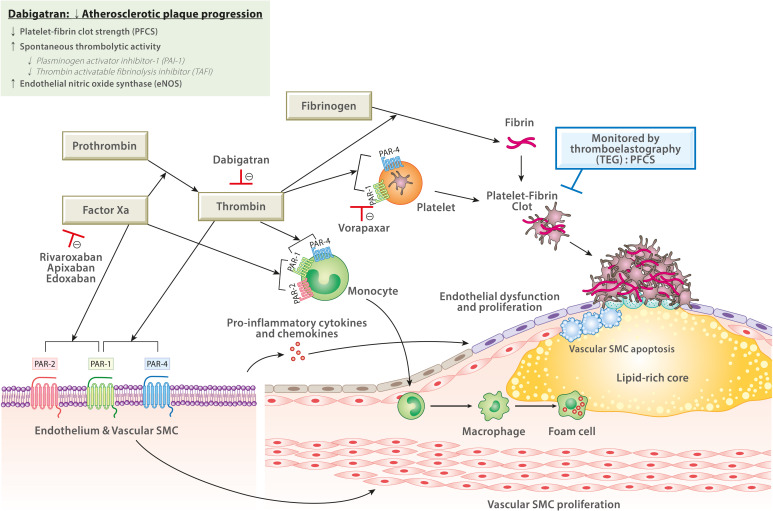Korean Circ J.
2020 Sep;50(9):817-821. 10.4070/kcj.2020.0287.
Another Unmet Need against Residual Risk of Atherosclerotic Cardiovascular Disease: Can “Thrombin Pathway” Be a New Target for Therapy?
- Affiliations
-
- 1Department of Internal Medicine, Chosun University School of Medicine, Chosun University Hospital, Gwangju, Korea
- 2Sinai Center for Thrombosis Research and Drug Development, Sinai Hospital of Baltimore, Baltimore, MD, USA
- 3Department of Internal Medicine, Gyeongsang National University School of Medicine and Cardiovascular Center, Gyeongsang National University Changwon Hospital, Changwon, Korea
- KMID: 2505737
- DOI: http://doi.org/10.4070/kcj.2020.0287
Figure
Cited by 1 articles
-
Beginning the Journey to Find Optimal Antithrombotic Regimens for Korean Patients with Atrial Fibrillation after Percutaneous Coronary Intervention
Sung Soo Kim, Hyun Kuk Kim
Korean Circ J. 2021;51(5):423-425. doi: 10.4070/kcj.2021.0017.
Reference
-
1. Bhatt DL, Eagle KA, Ohman EM, et al. Comparative determinants of 4-year cardiovascular event rates in stable outpatients at risk of or with atherothrombosis. JAMA. 2010; 304:1350–1357. PMID: 20805624.
Article2. Capodanno D, Bhatt DL, Eikelboom JW, et al. Dual-pathway inhibition for secondary and tertiary antithrombotic prevention in cardiovascular disease. Nat Rev Cardiol. 2020; 17:242–257. PMID: 31953535.
Article3. Gurbel PA, Fox KA, Tantry US, Ten Cate H, Weitz JI. Combination antiplatelet and oral anticoagulant therapy in patients with coronary and peripheral artery disease. Circulation. 2019; 139:2170–2185. PMID: 31034291.
Article4. Jeong YH, Bliden KP, Shuldiner AR, Tantry US, Gurbel PA. Thrombin-induced platelet-fibrin clot strength: relation to high on-clopidogrel platelet reactivity, genotype, and post-percutaneous coronary intervention outcomes. Thromb Haemost. 2014; 111:713–724. PMID: 24336898.
Article5. Bae JS, Ahn JH, Jang JY, et al. The Impact of platelet-fibrin clot strength on occurrence and clinical outcomes of peripheral artery disease in patients with significant coronary artery disease. J Thromb Thrombolysis. 2020; [Epub ahead of print].
Article6. Jeong YH, Bliden K, Ahn JH, et al. Viscoelastic properties of clot formation and their clinical impact in East Asian versus Caucasian patients with stable coronary artery disease: a COMPARE-RACE analysis. J Thromb Thrombolysis. 2020; [Epub ahead of print].
Article7. Sanda T, Yoshimura M, Hyodo K, Ishii H, Yamashita T. Effects of long-term thrombin inhibition (dabigatran etexilate) on spontaneous thrombolytic activity during the progression of atherosclerosis in ApoE−/−–LDLR−/− double-knockout mice. Korean Circ J. 2020; 50:804–816. PMID: 32725990.8. Knuuti J, Wijns W, Saraste A, et al. 2019 ESC Guidelines for the diagnosis and management of chronic coronary syndromes. Eur Heart J. 2020; 41:407–477. PMID: 31504439.9. Anand SS, Bosch J, Eikelboom JW, et al. Rivaroxaban with or without aspirin in patients with stable peripheral or carotid artery disease: an international, randomised, double-blind, placebo-controlled trial. Lancet. 2018; 391:219–229. PMID: 29132880.10. Huo Y, Jeong YH, Gong Y, et al. 2018 update of expert consensus statement on antiplatelet therapy in East Asian patients with ACS or undergoing PCI. Science Bulletin. 2019; 64:166–179.
Article
- Full Text Links
- Actions
-
Cited
- CITED
-
- Close
- Share
- Similar articles
-
- Cardiovascular Risk Factors: It's Time to Focus on Variability!
- Psoriasis and Cardiovascular Disease: A Narrative Review
- Residual Cardiovascular Risk Remains Despite of Statin Treatment: Importance of High-Density Lipoprotein Cholesterol
- Atherosclerotic Cardiovascular Disease Risk and Statin Prescription Status in Korean Adult Patients
- Pharmacological Strategies beyond Statins: Ezetimibe and PCSK9 Inhibitors


